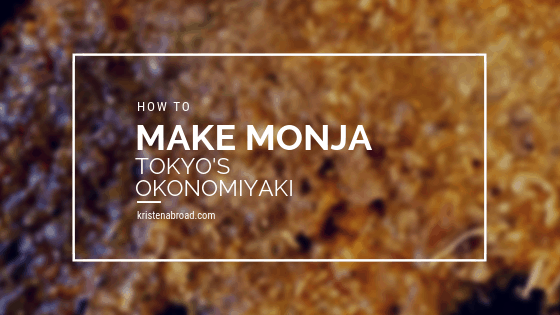Regional specialties of food abound in Japan. However, even though Tokyo has the most Michelin starred restaurants (including ramen restaurants!) of any city in the world, they really only have one specialty. Enter Monjayaki (もんじゃ焼き) or Monja (もんじゃ). Said to originate in the Tsukishima (月島) area of Tokyo, this batter-fried dish similar to okonomiyaki (but more crepe than pancake!) can be intimidating to the uninitiated. You make it yourself, after all! Don’t let that scare you away from this must try Japanese food when you are visiting the Kanto Region of Japan.
Disclosure: Kristenabroad.com is a participant in the Amazon Services LLC Associates Program and other affiliate programs. For some links to products or services in this article, I may earn a small commission by you using my link. The price for you is not affected.
The History
What potentially started as a confectionery (more on that later), a manga from the early 1800s alludes to a shop that made something similar to what we now know as monjayaki. The modern-day creation is said to be created after the war in 昭和 20年 (Showa 20 or 1945 to us Westerners). Lack of supplies leads to creativity! Monja is, in essence, water downed flour.

Tsukishima (月島) Monja Street
Tsukushima Monja Street is a nickname for Nishinakadori (西仲通り). You must head to this awning-covered Showa-era arcade. There is no shortage of monjayaki restaurants full of self-cook griddles.
The Tsukishima Monja Promotion Association (月島もんじゃ振興会) has 60 member shops. Yes, there is a promotion association! The oldest monjayaki restaurant here, opened in 昭和25年 (Showa 25 or 1950).
How do you find this monja heaven? Head out from Tsukishima Station, Exit 7.
Making Monjayaki or Monja
Monjayaki is a participation event in the world of cooking. In Japan, it is common to go to restaurants and cook your own food on a grill or teppanyaki (hot iron plate — Americans: think Japanese steakhouses). Monja and okonomiyaki fall to the latter.
You can cook it yourself, or ask the restaurant staff to assist you if necessary. You’re on a page for making this yourself though! Throw yourself into the culture and follow these steps!
Remember making volcanos with your mashed potatoes growing up? No? Just me? Well, think of this process as you start to make your monjayaki.

Step 1:
You will be provided with a bowl of ingredients from the shop. First things first though, make sure to well oil your working surface. There will be several tools on the table at your disposal. Generally, a metal dish contains a brush is used for oiling the iron.
Step 2:
Once hot, add your solid ingredients to the skillet. This, however, is not okonomiyaki. Don’t mix the ingredients and don’t pour out the batter just yet. This can be tricky at first but give it a go!

Step 3:
This is the fun part. Use your spatulas (the larger ones, more on the small ones in a few) to chop up your cabbage and other ingredients. This I swear has to be where the gusto of chefs at Benihana comes from. Chop to your
Step 4:
Is the cabbage soft? Good, shape the ingredients like a round donut or volcano. I’ll leave which term you use up to you. It is Japan though. As much as Mr. Donuts is delicious, I’d vote they are more known for volcanos.
Step 5:
Now is the time for your batter. Pour the mixture of dashi and flour into your donut or volcano. Try to keep the banks from exploding though. Best not to pour all of the
Step 6:
Wait till the batter starts to boil then start mixing in the surrounding ingredients. You will then spread it thinly across the entire surface.
Step 7
Let it cook some more and then start eating! Keep the burner on! You want it slightly burnt and crispy.

The Ingredients
It isn’t monja without wheat flour and dashi (a magical Japanese broth found in many dishes). Monja shops distinguish themselves with this
Cabbage comes in next with being a near mandatory ingredient. Past that? The world is your oyster. Oh, and oyster and other seafood are great additions!
Mentaiko (salted walleye pollack roe with red pepper) and mochi are a popular combination. Add cheese to that and Magnifique!
Looking out for the shops specialties are a good way to go with what you choose!
How to eat Monjayaki
You’ll use the small, spatula-like utensil called a 箆 (へら,
Watch out though — it is metal. It will burn your mouth if you aren’t careful.
Don’t forget dessert
Monjayaki restaurants often offer あんこ巻き (あんこまき,

Like this post? Pin it for later



I Would love to eat this!
Awsome, you can learn about SEO, because this is the only way to drive organic traffic on your website